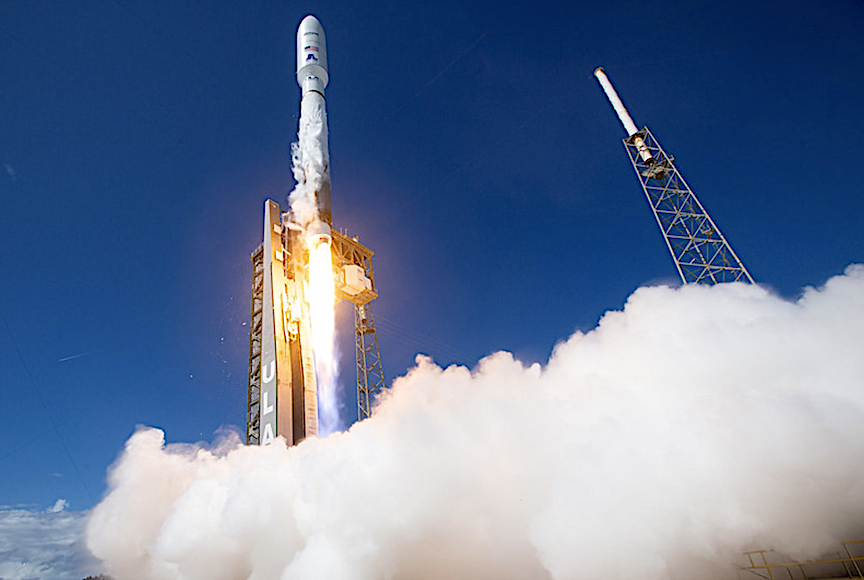
The United Launch Alliance Atlas V rocket carrying the Protoflight mission for Amazon’s Project Kuiper lifts off from Space Launch Complex-41 at 2:06 p.m. EDT on October 6.
Photo by United Launch Alliance
Success. A picture perfect launch as Atlas V precisely delivers initial Project Kuiper prototype satellites.

Alliance
Cape Canaveral Space Force Station, Fla., (October 6, 2023) – A United Launch Alliance (ULA) Atlas V rocket carrying the Protoflight mission for Amazon’s Project Kuiper lifted off on Oct. 6 at 2:06 p.m. EDT from Space Launch Complex-41 at Cape Canaveral Space Force Station. To date, ULA has launched 158 times with 100 percent mission success. The Protoflight launch is the first mission in a broader commercial partnership between ULA and Amazon to launch the majority of the Project Kuiper constellation.
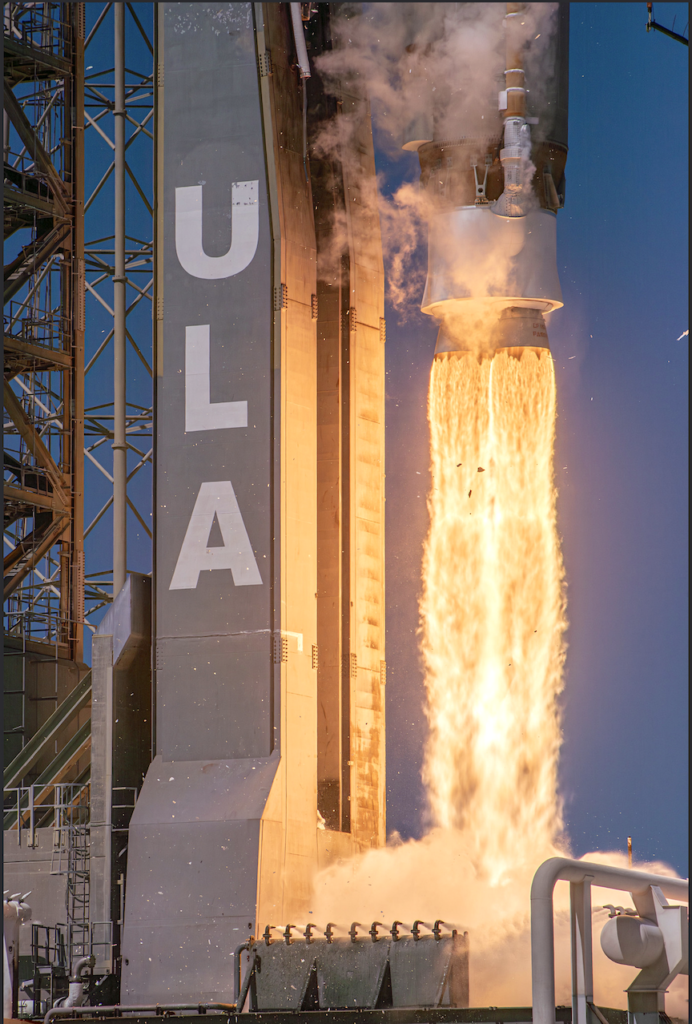
“This initial launch is the first step in support of deployment of Amazon’s initiative to provide fast, affordable broadband service to unserved and underserved communities around the world,” said Gary Wentz, ULA vice president of Government and Commercial Programs. “We have worked diligently in partnership with the Project Kuiper team to launch this important mission that will help connect the world. We look forward to continuing and building on the partnership for future missions.”
ULA’s next launch is the inaugural Vulcan mission from Cape Canaveral Space Force Station in Florida. The next generation Vulcan rocket will offer unprecedented flexibility in a single system with streamlined operations and greater affordability, while continuing to provide unmatched reliability and orbital precision.
Amazon purchased nine Atlas 5 launches for its internet constellation along with 38 flights aboard the forthcoming Vulcan rocket.
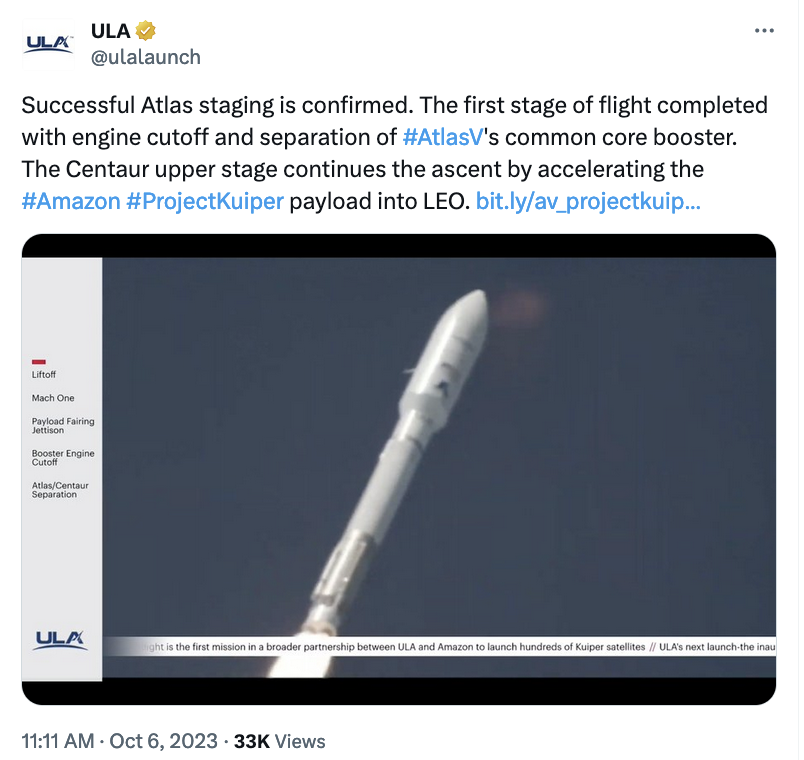
The Atlas V’s missions is used for interplanetary missions, military payloads and cargo deliveries to ISS. ULA’s Atlas V’s record includes more than 75 successful launches (as of March 2018) with no failures and is credited as one of ‘the most reliable in the world’ having launched the Pluto-bound New Horizons mission, the top-secret X-37B space plane and the Mars Curiosity rover.
In the future the Atlas V rocket will also be used to launch the Boeing CST-100 spacecraft to carry astronauts to the International Space Station.
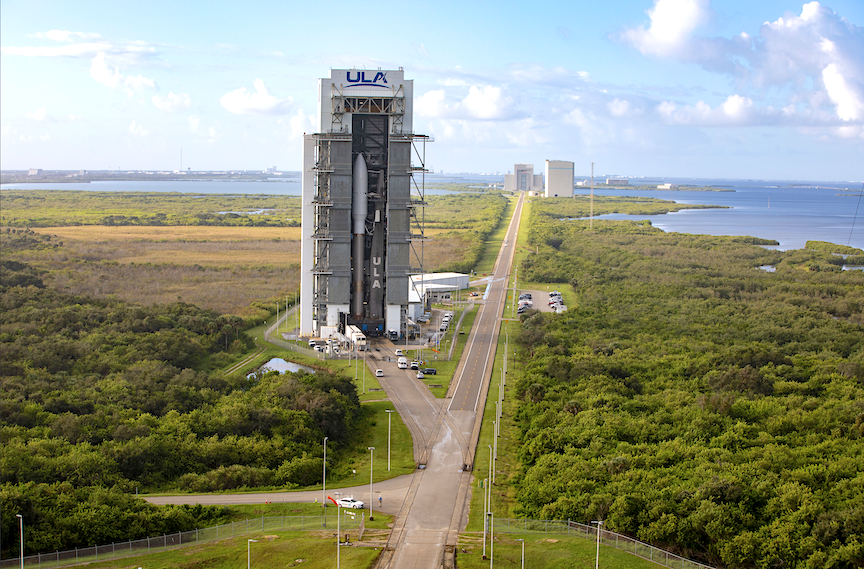
The United Launch Alliance Atlas V rocket is transported from the Vertical Integration Facility to Space Launch Complex-41 at Cape Canaveral, Florida, in preparation to launch Amazon’s Project Kuiper Protoflight mission. Photo by United Launch Alliance
LAUNCH-1: Everything continues to progress towards the ULA Atlas V launch carrying the Protoflight mission for Amazon’s Project Kuiper. The mission is planned to lift off on Fri., October 6 from Space Launch Complex-41 at Cape Canaveral Space Force Station in Florida. The two-hour launch window opens at 2 p.m. EDT. Today’s forecast shows a 70 percent chance of favorable weather conditions for launch.
Launch Forecast Summary:
Overall probability of violating weather constraints: 30%
Primary concerns: Thick Cloud Layers Rule, Cumulus Cloud Rule
Overall probability of violating weather constraints for 24-hour delay: 15%
Primary concern: Thick Cloud Layers Rule
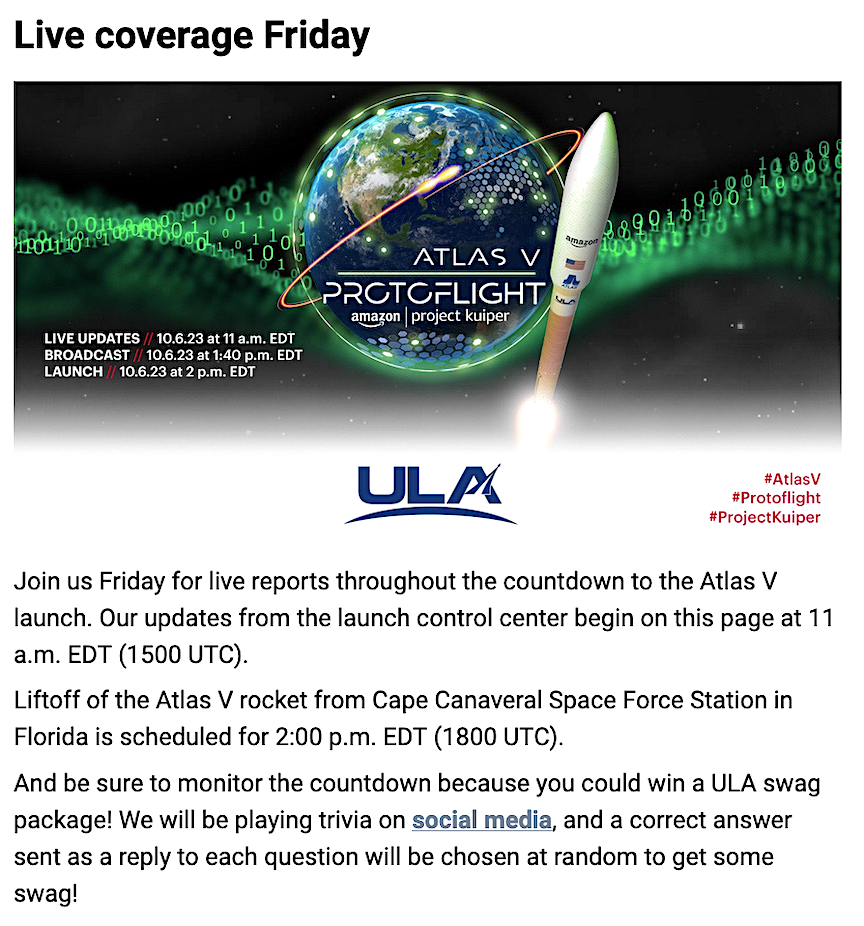
Mission Overview
A United Launch Alliance (ULA) Atlas V 501 rocket is launching the Protoflight mission for Amazon’s Project Kuiper. Liftoff will occur from Space Launch Complex-41 at Cape Canaveral Space Force Station, Florida. ULA’s Atlas V rocket will deliver two prototype satellites into low Earth orbit (LEO) for Project Kuiper, a LEO satellite network that will provide fast, affordable broadband to unserved and underserved communities around the world.
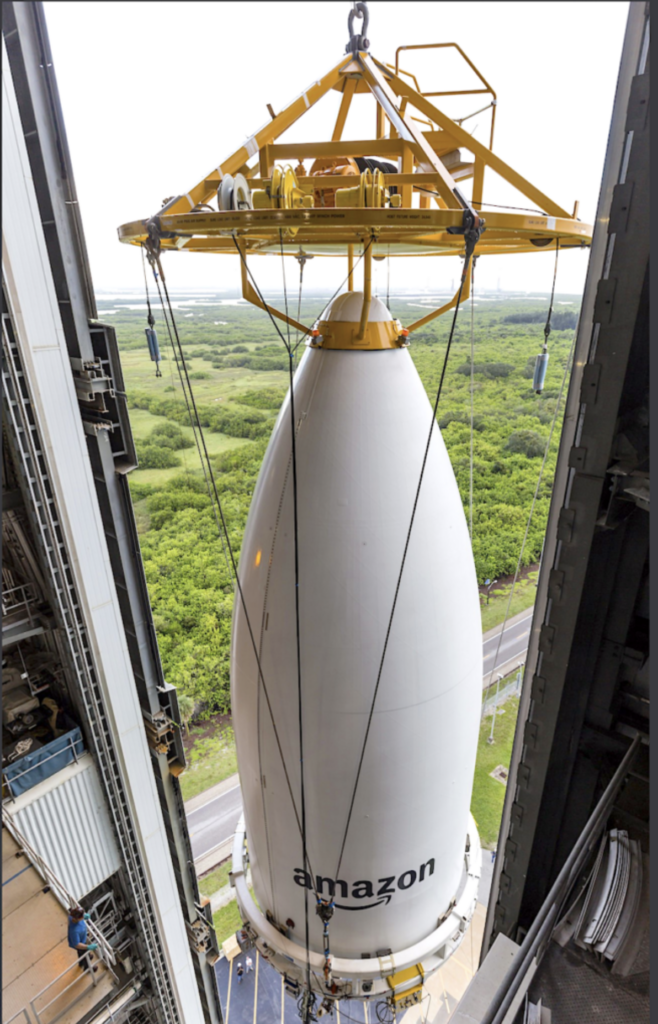
United Launch Alliance (ULA) hoists Amazon’s Project Kuiper Protoflight mission payload atop the Atlas V rocket in the Vertical Integration Facility (VIF) adjacent to Space Launch Complex-41 at Cape Canaveral Space Force Station. Photo credit: United Launch Alliance
LAUNCH 2: Everything continues to progress towards the ULA Atlas V launch carrying the Protoflight mission for Amazon’s Project Kuiper. The mission is planned to lift off on Friday, October 6 from Space Launch Complex-41 at Cape Canaveral Space Force Station in Florida. The two-hour launch window opens at 2 p.m. EDT. Today’s forecast shows an 80 percent chance of favorable weather conditions for launch.
Launch Forecast Summary:
Overall probability of violating weather constraints: 20%
Primary concerns: Cumulus Cloud Rule, Thick Cloud Layers Rule
Overall probability of violating weather constraints for 24-hour delay: 15%
Primary concern: Cumulus Cloud Rule

Wondering if you can see the Atlas V launch of Project Kuiper Protoflight? This visibility map shows when and where your best chances are to see the rocket as it lifts off Friday at 2:00 p.m. EDT (1800 UTC) from Cape Canaveral.
The Launch Readiness Review (LRR) is GO for Friday’s liftoff of the United Launch Alliance Atlas V rocket on the Project Kuiper Protoflight mission to place prototypes of Amazon’s satellite design into space for real-world testing.
Liftoff is scheduled for 2 p.m. EDT (1800 UTC) from Space Launch Complex-41 at Cape Canaveral Space Force Station in Florida. The available launch window extends for two hours.

The LRR, led by ULA Launch Director James Whelan, was completed this morning at the Advanced Spaceflight Operations Center (ASOC).
Leadership from ULA, Amazon and the Space Force assessed the readiness of the rocket, payload and mission assets, discussed the status of pre-flight processing work, heard technical overviews of the countdown and flight, and previewed the weather forecast that projects an 80 percent chance of meeting the launch rules.
At the conclusion of the meeting, senior leaders were polled and gave a ready status for launch, then signed the Launch Readiness Certificate.
The Atlas V 501 rocket, designated AV-104, stands 196 feet (59.7 meters) tall and will weigh 748,149 pounds (339,355 kg) when fully fueled at liftoff.
The Protoflight launch is the first mission in a broader partnership between ULA and Amazon to help deploy Project Kuiper’s low Earth orbit (LEO) satellite constellation. Amazon will use nine launches of the Atlas V rocket and 38 launches of Vulcan Centaur to deploy its satellites. The prototype mission gives ULA and Amazon practical experience working together ahead of full-scale launches, including processing procedures, payload integration and mission management.
ULA will offer live reports from launch control in our automatically-refreshing blog beginning Friday at 11 a.m. EDT (1500 UTC). The launch webcast starts at 1:40 p.m. EDT (1740 UTC).
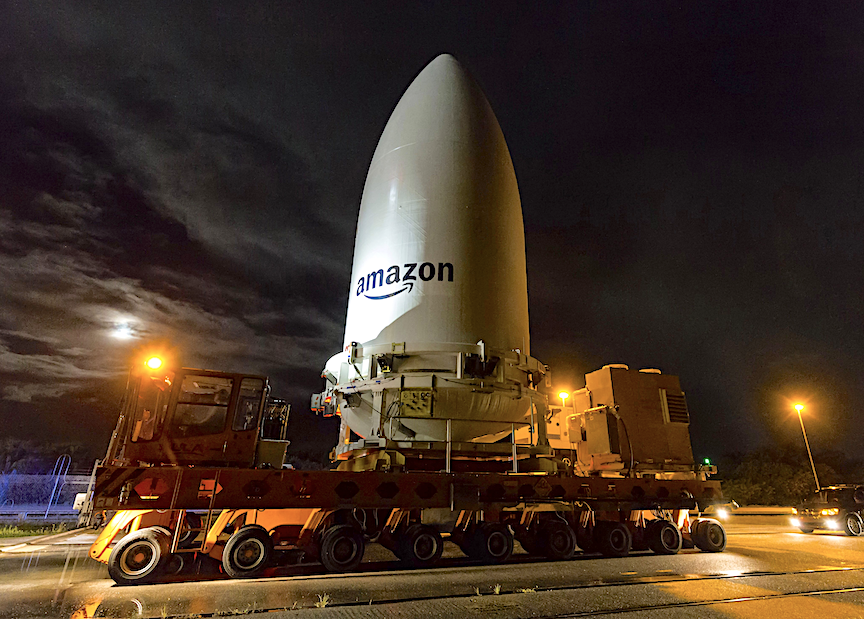
L-3 UPDATE: Everything continues to progress towards the ULA Atlas V launch carrying the Protoflight mission for Amazon’s Project Kuiper. The mission is planned to lift off on Friday, October 6 from Space Launch Complex-41 at Cape Canaveral Space Force Station in Florida. The launch window opens at 2 p.m. EDT. Today’s forecast shows an 80 percent chance of favorable weather conditions for launch.
The forecast from the Space Force’s Space Launch Delta 45 weather squadron and Launch Weather Officer Melody Lovin for Friday’s launch of Atlas V indicates an 80 percent chance of acceptable conditions.
“By Friday, the ridge across the eastern Continental U.S. weakens and shifts into the north Atlantic, loosening the pressure gradient and thereby our winds and moisture levels in time for launch day. Showers and thunderstorms cannot be completely ruled out but should be on the isolated side Friday afternoon,” the weather team says.
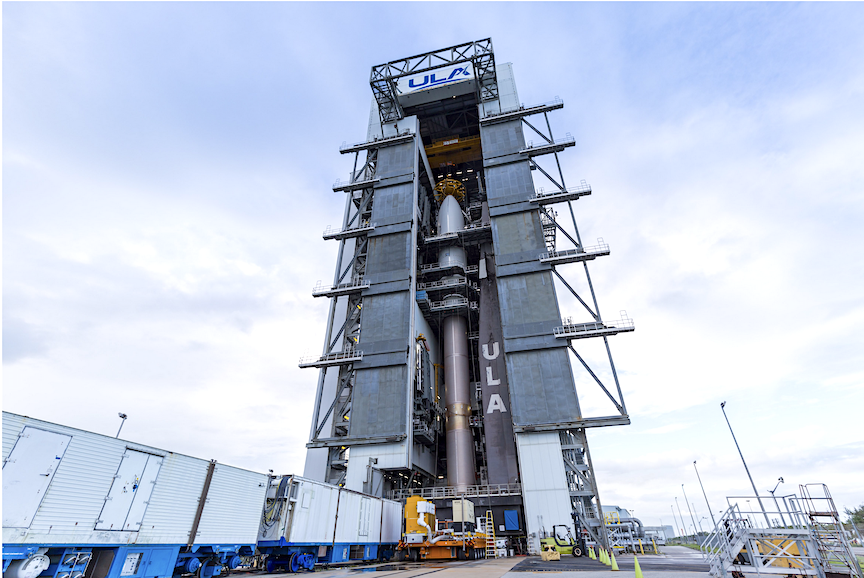
The launch time forecast for 2:00 p.m. EDT (1800 UTC) includes scattered clouds, possible isolated showers, good visibility, northerly winds 8 to 12 knots and a temperature near 81 degrees F.
If the launch moves to the backup opportunity on Saturday for some reason, there is an 85 percent chance of meeting the weather rules with similar but drier conditions expected.
Launch Forecast Summary:
Overall probability of violating weather constraints: 20%
Primary concerns: Cumulus Cloud Rule
Overall probability of violating weather constraints for 24-hour delay: 15%
Primary concern: Cumulus Cloud Rule
Standing nearly 20 stories tall, the Atlas V 501 rocket will deliver its payload into low Earth orbit as part of the Project Kuiper Protoflight mission for Amazon. The prototypes of the final Kuiper satellite design will allow Amazon to test its technology in space before beginning full-scale production launches next year.
The Protoflight launch is also the first mission in a broader partnership between ULA and Amazon to help deploy Project Kuiper’s low Earth orbit (LEO) satellite constellation. Amazon will use nine launches of the Atlas V rocket and 38 launches of Vulcan Centaur to deploy its satellites. The prototype mission gives ULA and Amazon practical experience working together ahead of full-scale launches, including processing procedures, payload integration and mission management.
Atlas V will place two spacecraft — Kuipersat-1 and Kuipersat-2 — in 311-mile (500-km) orbits with an inclination of 30 degrees. Centaur uses a single burn to place the satellites into their desired perch and deploys them approximately 18 minutes after liftoff, at which point Amazon will assume control of the satellites and proceed with testing.
The Protoflight mission will add real-world data from space to Amazon’s results from its extensive lab testing, fieldwork and simulation, and help Amazon finalize plans ahead of a full-scale satellite deployment beginning in 2024.
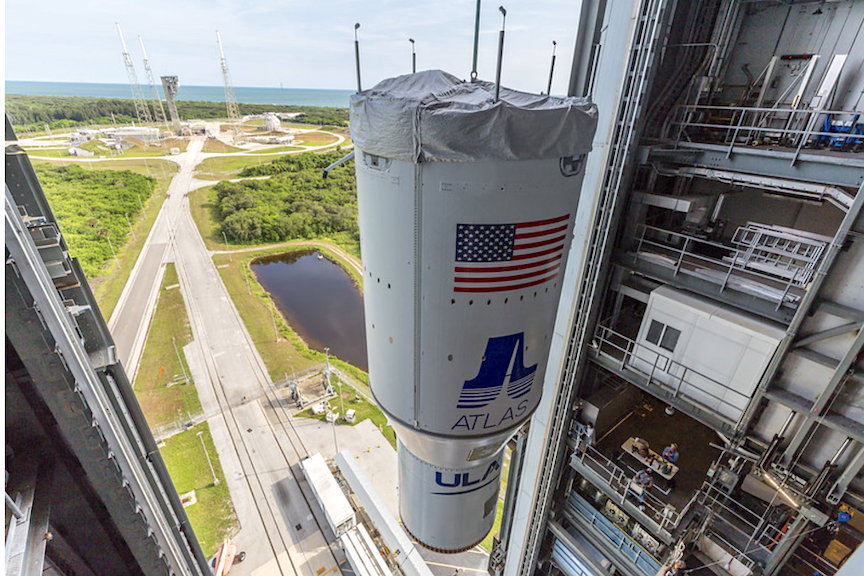
The Centaur upper stage is brought to the Vertical Integration Facility at Cape Canaveral, Florida, and placed atop the first stage of the United Launch Alliance Atlas V rocket in preparation to launch Amazon’s Project Kuiper Protoflight mission. Photo by United Launch Alliance
L-4 UPDATE: Everything continues to progress towards the ULA Atlas V launch carrying the Protoflight mission for Amazon’s Project Kuiper. The mission is planned to lift off on Fri., October 6 from Space Launch Complex-41 at Cape Canaveral Space Force Station in Florida.
The launch window opens at 2 p.m. EDT. Today’s forecast shows an 80 percent chance of favorable weather conditions for launch.
Launch Forecast Summary:
Overall probability of violating weather constraints: 20%
Primary concerns: Cumulus Cloud Rule, Surface Electric Fields Rule
Overall probability of violating weather constraints for 24-hour delay: 15%
Primary concern: Cumulus Cloud Rule
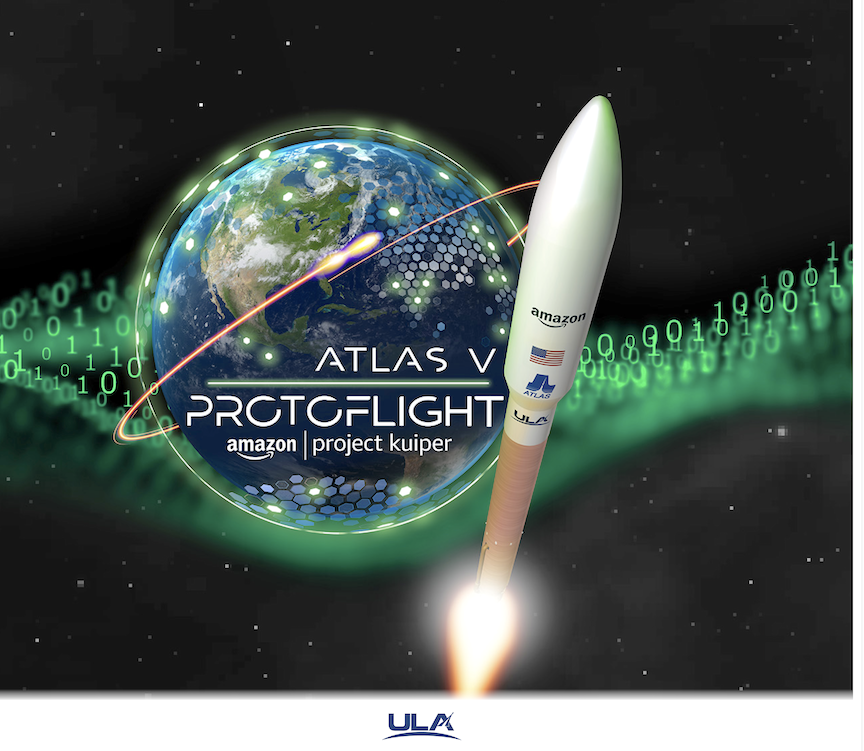
The launch of a United Launch Alliance (ULA) Atlas V 501 rocket carrying Amazon’s Project Kuiper Protoflight mission is planned for Fri., Oct. 6 from Space Launch Complex-41 at Cape Canaveral Space Force Station, Florida. The launch window opens at 2 p.m. EDT.Liftoff will occur from Space Launch Complex-41 at Cape Canaveral Space Force Station, Florida.
Launch Date: October 6, 2023
Launch Window: Opens at 2 p.m. EDT
GO Atlas V! GO Centaur! GO Project Kuiper! GO Protoflight!

Launch status update
(Cape Canaveral Space Force Station, Fla., Sept. 28, 2023) – The launch of a United Launch Alliance (ULA) Atlas V 501 rocket carrying Amazon’s Project Kuiper Protoflight mission is planned for Fri., Oct. 6 from Space Launch Complex-41 at Cape Canaveral Space Force Station, Florida. The launch window opens at 2 p.m. EDT.
Protoflight: Atlas V stacked ahead of first Kuiper launch
United Launch Alliance (ULA) uses heavy-duty cranes, teamwork and a lot of coordination to assemble our massive rockets before they head into space. That art of rocket stacking is both time-tested and an obligation to some passengers who require vertical integration of their payloads.
This week, engineers and technicians at Cape Canaveral Space Force Station, Florida, completed the initial buildup of the Atlas V 501 rocket that will launch prototypes of the Project Kuiper broadband system for Amazon.
The satellites will add real-world data from space to results from Amazon’s extensive lab testing, fieldwork, and simulation. This Protoflight mission also helps Amazon finalize design, deployment and operational plans ahead of a full-scale deployment beginning in 2024.
Preparations for this first launch began Sept. 16 with the Launch Vehicle on Stand (LVOS) milestone.
Before sunrise, the move crew arrived at the Advanced Spaceflight Operations Center (ASOC) to configure the Atlas V first stage for its delivery to the Vertical Integration Facility (VIF), located about four miles up the road.
more information follows at this blog...
